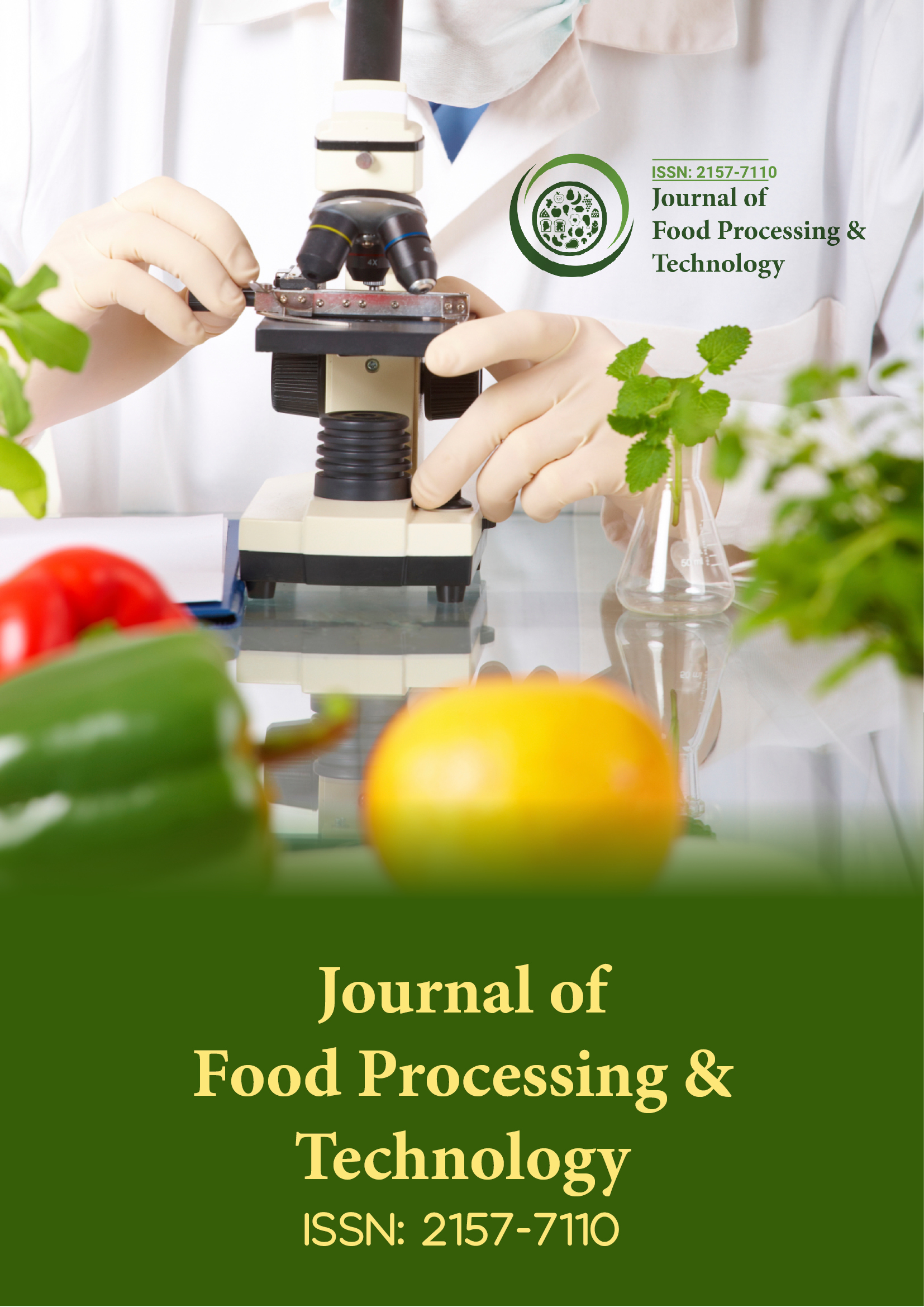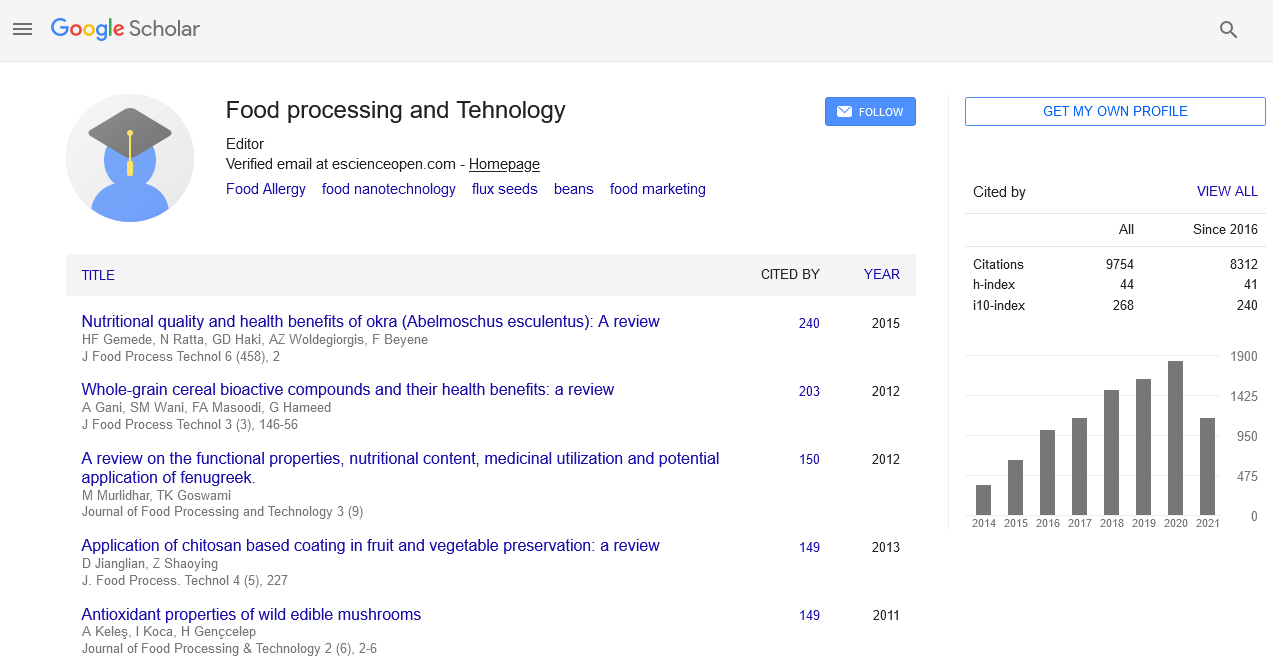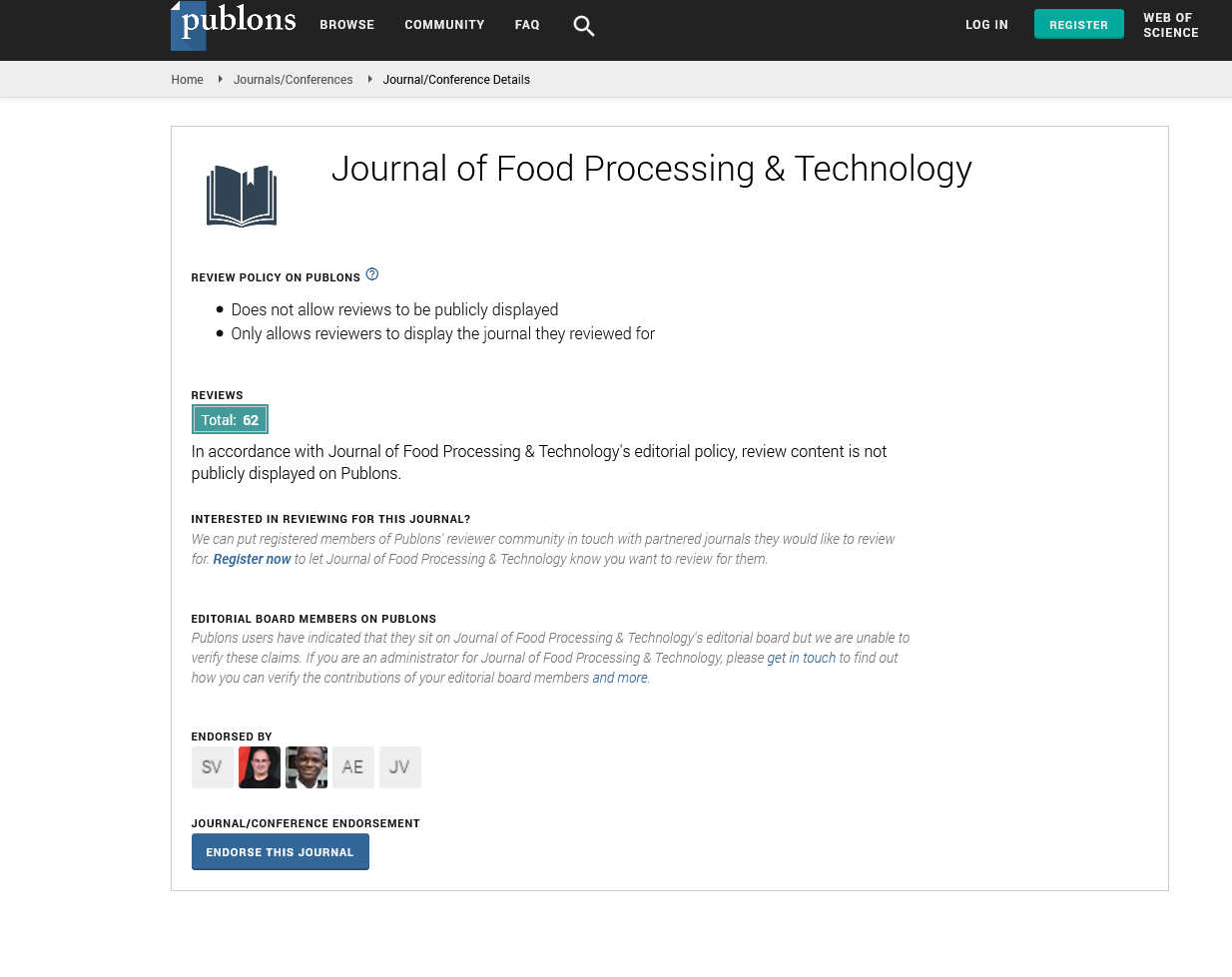Indexed In
- Genamics JournalSeek
- Academic Keys
- JournalTOCs
- China National Knowledge Infrastructure (CNKI)
- Access to Global Online Research in Agriculture (AGORA)
- Centre for Agriculture and Biosciences International (CABI)
- RefSeek
- Directory of Research Journal Indexing (DRJI)
- Hamdard University
- EBSCO A-Z
- OCLC- WorldCat
- Scholarsteer
- SWB online catalog
- Publons
- Euro Pub
- Google Scholar
Useful Links
Share This Page
Journal Flyer

Open Access Journals
- Agri and Aquaculture
- Biochemistry
- Bioinformatics & Systems Biology
- Business & Management
- Chemistry
- Clinical Sciences
- Engineering
- Food & Nutrition
- General Science
- Genetics & Molecular Biology
- Immunology & Microbiology
- Medical Sciences
- Neuroscience & Psychology
- Nursing & Health Care
- Pharmaceutical Sciences
Short Communication - (2025) Volume 16, Issue 3
Valorization of Fruit Peels in Food Processing for Sustainable Ingredient Development
Sofia Almeida*Received: 26-May-2025, Manuscript No. JFPT-25-29658; Editor assigned: 28-May-2025, Pre QC No. JFPT-25-29658; Reviewed: 11-Jun-2025, QC No. JFPT-25-29658; Revised: 19-Jun-2025, Manuscript No. JFPT-25-29658; Published: 25-Jun-2025, DOI: 10.35248/2157-7110.25.16.1158
Description
Fruit peels, often discarded as waste, are increasingly being recognized as valuable resources due to their high content of dietary fiber, antioxidants, vitamins, minerals, and other bioactive compounds. Traditionally, fruit peels were considered by-products of food processing and home consumption, often ending up in landfills or as animal feed. However, with rising awareness of food waste, environmental sustainability, and functional nutrition, researchers and food industries are exploring innovative ways to incorporate fruit peels into new food products [1]. This shift not only addresses the growing problem of food waste but also adds functional and economic value to what was previously considered refuse. Citrus peels, mango skins, and banana peels are particularly noteworthy due to their rich profiles of polyphenols, flavonoids, carotenoids, and natural pigments. These bioactive compounds are known for their antioxidant, anti-inflammatory, and antimicrobial properties, making fruit peels promising candidates for natural food preservation. For example, flavonoids present in orange and lemon peels have been shown to inhibit the growth of certain foodborne pathogens, suggesting that peel extracts could be used as natural preservatives in a variety of food products. Similarly, mango peels contain mangiferin, a powerful antioxidant that contributes to reducing oxidative stress and extending the shelf life of processed foods [2].
The incorporation of powdered fruit peels into baked goods, beverages, and functional snacks represents one of the most practical applications. Banana peel flour, for instance, has been successfully tested as a partial substitute for wheat flour in bread, muffins, and cakes. Studies show that replacing even 5–10% of wheat flour with banana peel flour enhances dietary fiber content, improves antioxidant capacity, and introduces subtle flavor variations without negatively affecting texture or volume [3]. This approach not only improves the nutritional profile of baked products but also appeals to health-conscious consumers who are increasingly seeking high-fiber and naturally fortified foods. Citrus peels have also gained attention for their dual role as natural colorants and preservatives. The bright yellow, orange, and red pigments in lemon, orange, and tangerine peels can be extracted and used as natural alternatives to synthetic dyes in beverages, confectionery, and bakery items. In addition, citrus peel extracts can contribute antimicrobial activity against bacteria and fungi, reducing the need for artificial additives. These properties make fruit peel extracts highly attractive for clean-label product development, which has become a key trend in the food industry [4].
Another promising application is the extraction of pectin from fruit peels, particularly from apples and citrus fruits. Pectin is a natural gelling agent commonly used in jams, jellies, and other confectionery products. By utilizing fruit peel-derived pectin, producers can enhance dietary fiber intake while simultaneously reducing processing waste. Additionally, peel-derived pectin may contain bioactive compounds that confer additional health benefits, such as cholesterol reduction and improved gut health, further increasing the functional value of these products [5]. Beyond baked goods and jams, fruit peels are being explored in beverages, snacks, and even meat products. For example, powdered mango peel has been added to smoothies and protein shakes to increase fiber and antioxidant content. Orange peel extracts have been tested in meat preservation, reducing microbial growth and lipid oxidation while imparting subtle citrus flavor. These applications demonstrate the versatility of fruit peels and their potential to replace synthetic additives across a wide range of food categories [6].
Valorizing fruit peels aligns closely with circular economy principles, in which by-products and waste streams are converted into valuable, marketable resources. By integrating fruit peels into food products, companies can reduce environmental impact, lower waste disposal costs, and create new revenue streams [7]. Furthermore, consumers have shown positive acceptance of fruit peel-based products, especially among those who prioritize natural, sustainable, and functional foods. Market research indicates that products labeled as “fortified with natural ingredients” or “made from upcycled fruit” attract particular interest from health-conscious and environmentally aware buyers [8]. Despite the clear benefits, challenges remain. Standardizing processing methods to ensure safety, nutritional consistency, and regulatory compliance is critical. Fruit peels can contain pesticide residues, microbial contaminants, or antinutritional factors, so proper cleaning, drying, and processing protocols must be established [9]. Additionally, balancing taste and texture in products containing peel powders requires careful formulation, as high concentrations may impart bitterness or affect mouthfeel. Ongoing research is therefore focusing on optimizing extraction methods, improving sensory properties, and assessing long-term health benefits [10].
References
- Lv M, Liu Y, Geng JH, Kou XH, Xin ZH, Yang DY. Engineering nanomaterials-based biosensors for food safety detection. Biosens Bioelectron. 2018;106:122–128.
[Crossref] [Google Scholar] [PubMed]
- Lomeli-Martin A, Martínez LM, Welti-Chanes J, Escobedo-Avellaneda Z. Induced Changes in Aroma Compounds of Foods Treated with High Hydrostatic Pressure: A Review. Foods. 2021;10:878.
[Crossref] [Google Scholar] [PubMed]
- Huang H, Chen B, Wang C. Comparison of high pressure and high temperature short time processing on quality of carambola juice during cold storage. J Food Sci Technol. 2018;55:1716–1725.
[Crossref] [Google Scholar] [PubMed]
- Margosch D, Ehrmann MA, Buckow R, Heinz V, Vogel RF, Gänzle MG. High-Pressure-Mediated Survival of Clostridium botulinum and Bacillus amyloliquefaciens Endospores at High Temperature. Appl Environ Microbiol. 2006;72:3476–3481.
[Crossref] [Google Scholar] [PubMed]
- Koseki S, Yamamoto K. Modelling the Bacterial Survival/Death Interface Induced by High Pressure Processing. Int J Food Microbiol. 2007;116:136–143.
[Crossref] [Google Scholar] [PubMed]
- Chien SY, Sheen S, Sommers CH, Sheen LY. Modeling the Inactivation of Intestinal Pathogenic Escherichia coli O157:H7 and Uropathogenic E. coli in Ground Chicken by High Pressure Processing and Thymol. Front Microbiol. 2016;7:920.
[Crossref] [Google Scholar] [PubMed]
- Donsì G, Ferrari G, Maresca P. Pasteurization of Fruit Juices by Means of a Pulsed High Pressure Process. J Food Sci. 2010;75:169–177.
[Crossref] [Google Scholar] [PubMed]
- Luu S, Cruz-Mora J, Setlow B, Feeherry FE, Doona CJ, Setlow P. The Effects of Heat Activation on Bacillus Spore Germination, with Nutrients or under High Pressure, with or without Various Germination Proteins. Appl Environ Microbiol. 2015;81:2927–2938.
[Crossref] [Google Scholar] [PubMed]
- Chung YK, Yousef AE. Inactivation of barotolerant strains of Listeria monocytogenes and Escherichia coli O157: H7 by ultra-high pressure and tert-butylhydroquinone combination. J Microbiol. 2008;46(3):289-294.
[Crossref] [Google Scholar] [PubMed]
- Yang P, Rao L, Zhao L, Wu X, Wang Y, Liao X. High Pressure Processing Combined with Selected Hurdles: Enhancement in the Inactivation of Vegetative Microorganisms. Compr Rev Food Sci Food Saf. 2021;20:1800–1828.
[Crossref] [Google Scholar] [PubMed]
Citation: Almeida S (2025). Valorization of Fruit Peels in Food Processing for Sustainable Ingredient Development. J Food Process Technol.16: 1158.
Copyright: © 2025 Almeida S. This is an open access article distributed under the terms of the Creative Commons Attribution License, which permits unrestricted use, distribution and reproduction in any medium, provided the original author and source are credited.


